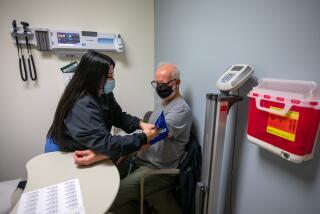Who Lives, Who Dies, Who Decides
- Share via
The problem: Hospice patients, supposedly near death, are living too long.
The solution: Operation Restore Trust has been set up by the Health and Human Services Department to combat waste in hospice care. Some hospice providers now fear they may have to repay the government millions of dollars spent on care for those who live longer than the HHS limit of six months. Next on the agenda, physician-assisted suicide.
Some people would respond, so who wants to prolong life at that stage anyway? When I was healthy, I would have agreed. I’d just stash some pills, invite my family and friends in to say goodbye, and that would be it.
Well, after eight years as a cancer patient, after seven years as a member of a hospice support group, after witnessing more than 100 deaths, I have never once seen a script that resembles the one I’d written for myself.
Karen Chapell, a beautiful 42-year-old dying of bone cancer, typifies the metamorphosis that takes place when someone is told she is terminal. Her first concerns were about pain, loss of dignity and the economic burden on her daughter: “When I can no longer take care of myself, I want out. Period.” Six months later she needed to use a walker. Four months after that she was in a wheelchair and her hospice support group was helping her with housework. Another two months and she was confined to bed. Her daughter had quit her job to take care of her. After six weeks, she was transferred to a hospice. Her daughter slept in her mother’s room, smoothing her brow, moistening her lips. When I visited Karen the day before her death, liver failure had turned her face and bald head a bright orange, her emaciated body was curved in a fetal position, her mouth was hanging open like a baby bird’s waiting to be fed. “How do I look?” she whispered. “Beautiful,” I answered. And I meant it. Her simple humanity overpowered everything else in the room.
“I wouldn’t have missed one moment of this ending,” she said.
Dr. Marion Primomo, a pioneer in hospice care agrees. “Almost all hospice patients who initially request suicide change their minds as soon as they feel cared for. Only one in 1,000 actually follows through.”
It would be enormously cost effective to assist people to end their lives. The taxpayers would get good value for their money. But do we really want anyone to opt for suicide because it’s cost effective? Or because they have no one to care for them?
Most people agree, theoretically, that when death is imminent, we should be given only compassionate care. But what if your 25-year-old daughter has third-stage ovarian cancer? Yes, it would be cost effective to deny her treatment, but it would be even more economical if she were subtly persuaded that a speedy assisted suicide would be in everyone’s best interest.
There are no easy answers. The American Medical Assn. is profoundly opposed to doctor-assisted suicide, yet ask any doctor to really level with you and he will tell you that patients always have been helped to die. Even some ministers support assisted suicide.
But I’ve come to believe that facing death gives real meaning to our lives. After seven years, I have never seen a lack of dignity in the hospice I am associated with, and most of the patients there remain pain-free and alert up to the last few days. Even those without families are honored and respected by the staff as they undergo the process of closing down.
If we really care enough and open our hearts as well as our pocketbooks, it can be done. In a book, “Share the Care: How to Organize a Group to Care for Someone Who Is Seriously Ill,” Cappy Capossela and Sheila Warnock wrote about 12 people who gathered around a dying friend, each volunteering to do one thing: pay her bills, bring her dinner once a week, help her bathe. Their friend lived three long and peaceful years, and all were enriched by the experience.
When patients learn to accept the support around them, they almost always choose life instead of death. So should we offer people in the dying process good, palliative, loving care? Or a great big shot of morphine?






